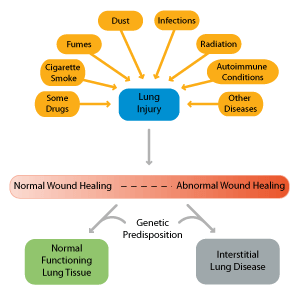Familial Pulmonary Fibrosis: Causes
This information was reviewed and approved by Jeff Swigris, DO, MS
 Clinical Trials
Clinical Trials
For more than 100 years, National Jewish Health has been committed to finding new treatments and cures for diseases. Search our clinical trials.

 When the lung is injured the body responds by healing the wound. Abnormal wound healing can lead to the development of excess scar tissue (fibrosis) and interstitial lung disease.
When the lung is injured the body responds by healing the wound. Abnormal wound healing can lead to the development of excess scar tissue (fibrosis) and interstitial lung disease.